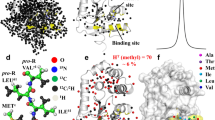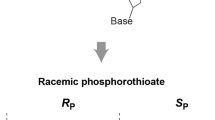Abstract
Interactions of proteins with small molecules or other macromolecules play key roles in many biological processes and in drug action, and NMR is an excellent tool for their structural characterization. Frequently, however, line broadening due to intermediate exchange completely eliminates the signals needed for measuring specific intermolecular NOEs. This limits the use of NMR for detailed structural studies in such kinetic situations. Here we show that an optimally chosen excess of ligand over protein can reduce the extent of line broadening for both the ligand and the protein. This makes observation of ligand resonances possible but reduces the size of the measurable NOEs due to the residual line broadening and the non-stoichiometric concentrations. Because the solubility of small molecule drug leads are often limited to high micromolar concentrations, protein concentrations are restricted to even lower values in the low micromolar range. At these non-stoichiometric concentrations and in the presence of significant residual line broadening, conventional NOESY experiments very often are not sensitive enough to observe intermolecular NOEs since the signals inverted by the NOESY preparation pulse sequence relax prior to significant NOE build up. Thus, we employ methods related to driven NOE spectroscopy to investigate protein–ligand interactions in the intermediate exchange regime. In this approach, individual protein resonances are selectively irradiated for up to five seconds to build up measurable NOEs at the ligand resonances. To enable saturation of individual protein resonances we prepare deuterated protein samples selectively protonated at a few sites so that the 1D 1H spectrum of the protein is resolved well enough to permit irradiation of individual protein signals, which do not overlap with the ligand spectrum. This approach is suitable for measuring a sufficiently large number of protein–ligand NOEs that allow calculation of initial complex structures, suitable for structure-based optimization of primary drug leads obtained from high-throughput screening. The method was applied to measure individual intermolecular NOEs between the anti-apoptotic protein Bcl-xL at 25 μM and a “first generation” small-molecule ligand, for which the spectrum is entirely broadened at stoichiometric concentrations. This approach is general and can also be used to characterize protein–protein or protein–nucleic-acid complexes.
Similar content being viewed by others
Abbreviations
- NMR:
-
nuclear magnetic resonance
- NOE:
-
nuclear Overhauser effect
- NOESY:
-
2D NOE spectroscopy
- STD:
-
saturation transfer difference spectroscopy
- SOS NMR:
-
structural information using Overhauser effects and selective labeling
- NMR-DOC:
-
Nuclear Magnetic Resonance Docking of compounds
References
Arnett, K.L., Harrison, S.C. and Wiley, D.C. (2004) Proc. Natl. Acad. Sci. USA 101, 16268–16273.
Barda-Saad, M., Braiman, A., Titerence, R., Bunnell, S.C., Barr, V.A. and Samelson, L.E. (2005) Nat. Immunol. 6, 80–89.
Bunnell, S.C., Hong, D.I., Kardon, J.R., Yamazaki, T., McGlade, C.J., Barr, V.A. and Samelson, L.E. (2002) J. Cell Biol. 158, 1263–1275.
Chen, Y., Reizer, J., Saier, M.H. Jr., Fairbrother, W.J. and Wright, P.E. (1993) Biochemistry 32, 32–37.
Clore G.M. (2000) Proc. Natl. Acad. Sci. USA 97, 9021–9025.
Degterev, A., Lugovskoy, A., Cardone, M., Mulley, B., Wagner, G., Mitchison, T. and Yuan, J. (2001) Nat. Cell Biol. 3, 173–182.
Fahmy, A. and Wagner, G. (2002) J. Am. Chem. Soc. 124, 1241–1250.
Goto, N.K., Gardner, K.H., Mueller, G.A., Willis, R.C. and Kay, L.E. (1999) J. Biomol. NMR 13, 369–374.
Gross, J.D., Gelev, V.M. and Wagner, G. (2003) J. Biomol. NMR 25, 235–242.
Gross, J.D., Moerke, N.J., von der Haar, T., Lugovskoy, A.A., Sachs, A.B., McCarthy, J.E. and Wagner, G. (2003) Cell 115, 739–750.
Hajduk, P.J., Mack, J.C., Olejniczak, E.T., Park, C., Dandliker, P.J. and Beutel, B.A. (2004) J. Am. Chem. Soc. 126, 2390–2398.
Ikura M., Bax A. (1992). J Am. Chem. Soc. 114: 2433–2440
Kainosho, M., Torizawa, T., Iwashita, Y., Terauchi, T., Mei Ono, A. and Guntert, P. (2006) Nature 440, 52–57.
Kuntz, I.D., Meng, E.C. and Shoichet, B.K. (1994) Acc. Chem. Res. 27, 117–123.
Lugovskoy, A.A., Degterev, A.I., Fahmy, A.F., Zhou, P., Gross, J.D., Yuan, J. and Wagner, G. (2002) J. Am. Chem. Soc. 124, 1234–1240.
Marintchev, A. and Wagner, G. (2004) Q. Rev. Biophys. 37, 197–284.
Markus, M.A., Nakayama, T., Matsudaira, P. and Wagner G. (1994) Protein Sci. 3, 70–81.
Matsuo, H., Li, H., McGuire, A.M., Fletcher, C.M., Gingras, A.C., Sonenberg, N. and Wagner, G. (1997) Nat. Struct. Biol. 4, 717–724.
Matsuo, H., Walters, K.J., Teruya, K., Tanaka, T., Gasser, G.T., Lippard, S.J., Kyogoku, Y. and Wagner, G. (1999) J. Am. Chem. Soc. 121, 9903–9904.
Mayer, M. and Meyer, B. (1999) Angew. Chem. Int. Ed. Engl. 38, 17484–11788.
Mayer, M. and Meyer, B. (2001) J. Am. Chem. Soc. 123, 6108–6117.
Medek, A., Hajduk, P.J., Mack, J. and Fesik, S.W. (2000) J. Am. Chem. Soc. 122, 1241–1242.
Medek, A., Olejniczak, E.T., Meadows, R.P. and Fesik, S.W. (2000) J. Biomol. NMR. 18, 229–238.
Oberer, M., Marintchev, A. and Wagner, G. (2005) Genes Dev. 19, 2212–2223.
Otting, G., Senn, H., Wagner, G. and Wüthrich, K. (1986) J. Magn. Reson. 70, 500–505.
Pellecchia, M., Meininger, D., Dong, Q., Chang, E., Jack, R. and Sem, D.S. (2002) J. Biomol. NMR. 22, 165–173.
Reibarkh, M., Malia, T. and Wagner, G. (2006) J. Am. Chem. Soc. (in press).
Roehrl, M.H., Kang, S., Aramburu, J., Wagner, G., Rao, A. and Hogan, P.G. (2004) Proc. Natl. Acad. Sci. USA 101, 7554–7559.
Roehrl, M.H., Wang, J.Y. and Wagner, G. (2004a) Biochemistry 43, 16056–16066.
Roehrl, M.H., Wang, J.Y. and Wagner, G. (2004b) Biochemistry 43, 16067–16075.
Rosen, M.K., Gardner, K.H., Willis, R.C., Parris, W.E., Pawson, T. and Kay, L.E. (1996) J. Mol. Biol. 263, 627–636.
Sattler, M., Liang, H., Nettesheim, D., Meadows, R.P., Harlan, J.E., Eberstadt, M., Yoon, H.S., Shuker, S.B., Chang, B.S., Minn, A.J., Thompson, C.B. and Fesik, S.W. (1997) Science 275, 983–986.
Schieborr, U., Vogtherr, M., Elshorst, B., Betz, M., Grimme, S., Pescatore, B., Langer, T., Saxena, K. and Schwalbe, H. (2005) Chembiochem. 6, 1891–1898.
Shimada, I. (2005) Methods Enzymol. 394, 483–506.
Shuker, S.B., Hajduk, P.J., Meadows, R.P. and Fesik, S.W. (1996) Science 274, 1531–1534.
Solomon, I. (1955) Phys. Rev. 99, 559–565.
Sun, Z.J., Kim, K.S., Wagner, G. and Reinherz, E.L. (2001) Cell 105, 913–923.
Sun, Z.Y., Dotsch, V., Kim, M., Li, J., Reinherz, E.L. and Wagner, G. (1999) Embo. J. 18, 2941–2949.
Takahashi, H., Nakanishi, T., Kami, K., Arata, Y. and Shimada, I. (2000) Nat. Struct. Biol. 7, 220–223.
Torizawa, T., Shimizu, M., Taoka, M., Miyano, H. and Kainosho, M. (2004) J. Biomol. NMR. 30, 311–325.
Vinarov, D.A., Lytle, B.L., Peterson, F.C., Tyler, E.M., Volkman, B.F. and Markley, J.L. (2004) Nat. Methods 1, 149–153.
Wagner, G. and Wüthrich, K. (1979) J. Magn. Reson. 33, 675–680.
Walters, K.J., Matsuo, H. and Wagner, G. (1996) J. Am. Chem. Soc. 119, 5958–5959.
Yokoyama, S. (2003) Curr. Opin. Chem. Biol. 7, 39–43.
Acknowledgment
We thank Dr. Vladimir Gelev for providing the precursors for the methyl-labeling experiments. This research was supported by NIH (Grants GM47467, GM075879 and EB002026).
Author information
Authors and Affiliations
Corresponding author
Rights and permissions
About this article
Cite this article
Reibarkh, M., Malia, T.J., Hopkins, B.T. et al. Identification of individual protein–ligand NOEs in the limit of intermediate exchange. J Biomol NMR 36, 1–11 (2006). https://doi.org/10.1007/s10858-006-9028-7
Received:
Accepted:
Published:
Issue Date:
DOI: https://doi.org/10.1007/s10858-006-9028-7




